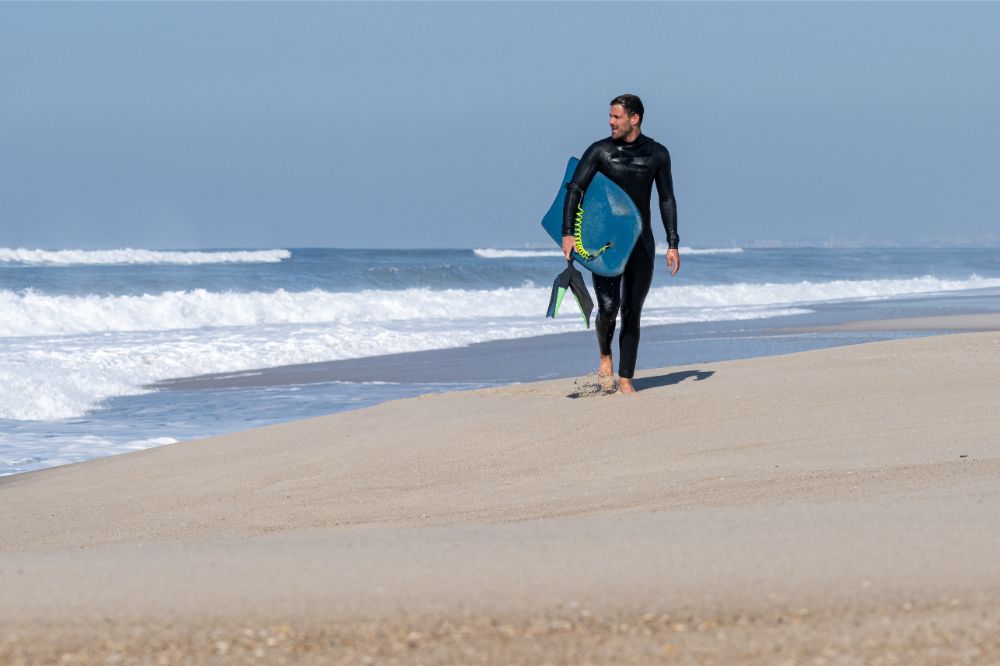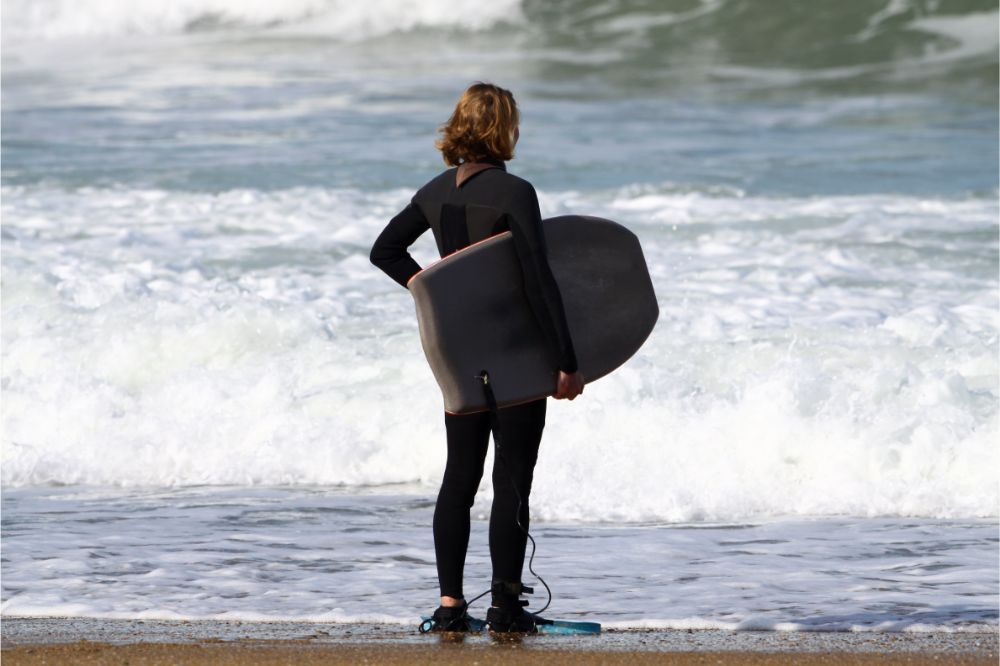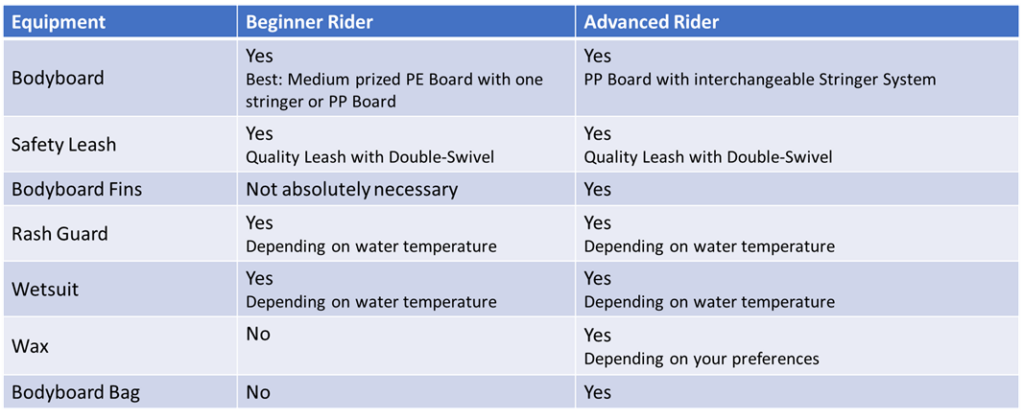Introduction to Bodyboarding
Imagine cruising down the face of a wave, slicing through the water with the white surf foaming behind. This is bodyboarding, an exhilarating sport that allows you to engage with the ocean like no other. At its core, bodyboarding is a simplified form of wave riding that uses a flat, buoyant board and the rider’s own body for control and propulsion. The appeal is its simplicity and accessibility; with a board and a will to ride the waves, you can get started.

You definitely need a good quality bodyboard suitable for your size and experience level. We also suggest that you own certain protective gear such as a wetsuit, rash guard, or sunscreen depending on the weather, saving you from hypothermia, sunburn, or other skin irritations right from the beginning. Lastly, a leash to keep your board attached to you at all times is vital, especially when starting out, to prevent you from losing your board. As you get more advanced, a pair of swim fins is also essential as it aids in catching larger waves and maneuvering on them.
In this article, we’re going to guide you through all the essentials you’ll need. By the end of it, you’ll be geared up and ready to dive headfirst into the incredible world of bodyboarding. So put your feet up, and let’s take a thrilling ride into this exciting adventure.
What do you need for Bodyboarding: Understanding the Equipment
Before hitting the waves, it’s important to familiarize yourself with all the equipment used in bodyboarding – this isn’t just about the board! The gear involved in bodyboarding extends to specially designed fins, leashes, wetsuits, or, depending on the water temperature your surfing in, rash guards. These pieces of equipment each play a critical role in not only enhancing your performance on the waves but also ensuring your safety in the water.
The bodyboard itself, of course, is key. Different board types and materials can dramatically influence your movement and control of the wave. Similarly, bodyboarding fins are designed to boost your propulsion in the water and help control your direction.
A leash will keep your bodyboard from floating away after a wipeout, saving you from a bothersome swim ashore. Your leash should be both comfortable and strong, and it needs to suit your bodyboarding style.
When it comes to maintaining your body temperature and preventing chafing, a properly fitted wetsuit or rash guard can make all the difference.
Finally, don’t forget about additional accessories like board bags, repair kits, and wax! Each piece of gear is an essential part of your bodyboarding experience. Now let’s dive deeper into each one, starting with the bodyboard.
Bodyboard
Moving on to the bodyboard itself – your gateway to riding the waves. It needs to be rugged enough to withstand the rigors of the ocean and maneuverable enough to let you carve your path. We’ll dive into different types and how to make a selection later on.
Types of Bodyboards
When it comes to bodyboards, there’s a variety to select from. They differ by size, material, and design, each suitable for particular wave conditions and the rider’s skill. From beginner-friendly to boards for pros, understanding these variations can be instrumental to your bodyboarding adventure.
Choosing the Right Bodyboard
Choosing the right bodyboard is crucial. Go for one that complements your weight, height, and expertise level. Beginners should opt for a larger board for stability while advanced riders may prefer a smaller one for better maneuverability. Always consider board specifications and materials for maximum durability and performance.
A closer look at how to choose the right bodyboard to enhance your overall surfing experience can be found in our Buying Guide.
Let’s now take a deeper dive into the importance of fins for bodyboarding.
Fins
Fins are another crucial bodyboarding equipment. They’re not needed to start off with Bodyboarding, but as soon as you reach a certain skill level, you’ll need them.
They provide propulsion in the water, help you catch waves more efficiently, and give you better control over your ride. They come in different types, sizes, and materials to fit various needs, skill levels, and water conditions.
Types of Fins
You’ll encounter a range of fins, from the classic Churchill Makapuus to modern variants like Viper V-7. Some excel in propulsion; others, maneuverability. Fins can have different materials, stiffness, and foot pocket design. Understanding these variations is crucial to picking fins that suit your style and water conditions.
Choosing the Right Fins
Selecting the right fins is crucial as they provide control during your ride. Consider factors like comfort, size, and material used, while making a purchase. For instance, softer fins are recommended for colder conditions. Additionally, the fins should fit well to prevent any discomfort during your bodyboarding adventure.
Bodyboarding fins come in various types to suit different needs. Classic fins are typically shorter and stiffer, offering quick burst speed ideal for bodyboarding in big waves. However, for those who prefer flexibility and comfort, hydrodynamic fins offer a longer, more flexible design. There are also combination fins, which offer the best of both worlds – comfort and speed. Ultimately, the choice depends on your bodyboarding style and preferences.
When choosing fins for bodyboarding, it’s vital to get the right size and fit. Make sure they’re comfortably snug, not too tight or loose. If possible, try them on with your wetsuit socks as they can alter the fit. Floating fins are a safe choice, as they won’t sink if they come off. Soft foot pockets and stiff blades offer a good balance between comfort and performance. Remember, fins are your motor in the water, so choose wisely!
In the following article, you can find more details about the best bodyboard fins. However, in contrast to the fins, we now want to have a deeper look at a part of the bodyboard equipment, you definitely need right from the beginning. Let’s now shift our focus to a key piece of bodyboarding equipment – the bodyboarding leash.

Safety Leash
In bodyboarding, the leash is crucial. Right from the beginning. It connects you to your board, ensuring it doesn’t get lost at sea during wipeouts. This essential piece of gear enhances your safety and allows you to retain your board even in the strongest waves.
Most of the beginner boards do have a pre-installed leash, so you just must make sure that you always wear it.
On the other hand, higher quality boards often do not come with an already installed leash. So if you choose to invest in a better board, you definitely need to think about which leash suits your needs best.
Types of Leashes
When it comes to leashes, choices abound. You’ve got straight leashes, which are classic and versatile. Coiled leashes reduce drag and are ideal for drop-knee bodyboarders, whereas bicep leashes offer a firm grip and are favored by many professionals. Picking the right one depends on your style and comfort.
Importance of a Good Leash
A good leash isn’t just about preventing board loss – it’s a matter of safety. It keeps your board within reach in case you wipe out, and can also be a lifesaver if you find yourself tired in the water. A good leash is a vital component for any bodyboarder.
However, another important feature a good leash must have is that it should not hinder you while surfing. So there are certain features like the material of the leash, its design and length, and the design of the swivel you should consider.
Significance of a Leash for Safety and Convenience.
The leash, often an overlooked piece of equipment, is crucial for both your safety and convenience when bodyboarding. Imagine riding a wave and then wiping out—without a quality leash, your board could potentially hit another person or get washed away. A leash saves you the effort of chasing your board and keeps it securely attached to you.
It’s a practical tool that guarantees an enjoyable and trouble-free bodyboarding experience. Remember, despite the thrilling nature of the sport, safety should always be your top priority, and a reliable leash is key to ensuring this.
Different Leash Options Available for Bodyboarding
When bodyboarding, leash choice matters. Standard wrist leashes typically suit most of the riders and their preferences, yet some surfers might prefer a bicep leash. Consider coils, cuff padding, and swivels to ensure comfort and durability. Don’t overlook color, ideally, one contrasting with your board for visibility.
How to Attach and Use the Leash Properly.
For attaching your leash, first secure it on the leash plug attached to your board. Once it’s fastened, wrap the other end around your upper arm or wrist, depending on where your leash is designed to attach. The proper usage of a leash involves making sure it’s snug, but not too tight, and ensuring it won’t interfere with your movement in the water. Stick to these guidelines for a safe bodyboarding trip!
Bodyboarding, Rash guard or Wetsuit
Wetsuit
In chilly waters, a wetsuit becomes essential for bodyboarding. Acting as a thermo-regulating barrier, it safeguards against hypothermia. Styles vary from spring suits designed for warmer climates to full suits for colder areas, keeping you warm, safe, and comfy while riding waves.
Choosing the Right Wetsuit
Picking the correct wetsuit ensures a comfortable ride. Consider the water temperature, as this determines wetsuit thickness. Also, consider the suit’s flexibility, which impacts your ability to move and paddle. Remember, proper fitting will prevent water flow within the wetsuit, providing optimum insulation during bodyboarding.
Rash Guards
Rash Guards are another essential gear while bodyboarding. They reduce friction between your body and the board while protecting your skin from the harsh sun and sea rash. Go for snug-fitting, quick-drying, and durable rash guards for best results.
Significance of a Rash Guard or Wetsuit/Rashguard/Clothing for Comfort and Warmth While Bodyboarding
When diving into the exhilarating world of bodyboarding, don’t overlook the importance of wearing a rash guard or wetsuit, or both. These pieces of gear play key roles in providing comfort and warmth, while also offering protection. In cool waters, a wetsuit keeps your body heat in, preventing hypothermia.
Rash guards, on the other hand, excel at preventing those troublesome chafe marks that come from extended contact between the body and board. They also protect against UV rays, offering an additional layer of defense when you’re out in the sun for extended periods. Some performers opt for a combination of wetsuit and rash guard, enjoying both warmth and surface protection.
Regardless of the water’s temperature, remaining comfortable increases your ability to perform, ultimately making your bodyboarding experience more enjoyable. So, don’t underestimate these items of clothing – they could be the real difference between a good and a great bodyboarding session.
Pros and Cons Between Wetsuit and Rashguard
Deciding between a wetsuit and a rashguard hinges on factors like water and weather conditions, as well as personal comfort. Wetsuits, although bulkier, provide commendable warmth in colder water and climates, making them a prime pick for chillier surf spots. They also offer added buoyancy and protection.
On the contrary, rashguards are lighter weight and less restrictive, which can enhance flexibility on the waves. They’re ideal for warmer environments and for protecting your skin from the sun and chafing. However, their lack of insulation might make them less suitable for cooler conditions. Both have their merits, but it ultimately boils down to your specific needs.
If you need more information about the right and useful Bodyboard apparel, check out this article here.
Following this understanding, it’s evident that the simplicity of bodyboarding— the nominal equipment requirement — contributed significantly to its rising popularity.
But alongside its evolution and expansion as a water sport, bodyboarding also offers a plethora of health benefits. We now delve into how bodyboarding has progressed over the years and the resulting health advantages that make it even more attractive.
Sport’s Popularity and Evolution
Bodyboarding has significantly grown in popularity over the years due to its exhilarating blend of thrill and fitness. Its evolution has played a key role in the modernization of surfing sports, offering a unique and easy path for adrenaline lovers who crave wave-riding action.
Unlike more traditional surfing methods, bodyboarding offers a more immersive touch with the waves, adding a layer of excitement and fun to the experience.
Furthermore: Bodyboarding is one of the most easy-to-learn extreme sports. Unlike other water sports, bodyboarding requires you to lie prone on the board, allowing full body contact with the wave and the board. This allows you to directly feel the power and movement of the wave beneath you, thereby increasing your grasp and control over the ride. The prone position also lowers the chances of you falling off and ensures a closer connection with the water.
Health Benefits
Bodyboarding isn’t just thrilling, it’s also a great workout! This sport has cardio benefits due to the intense paddling and wave riding, boosting heart health. It strengthens the body’s core and promotes balance. Plus, you’ll enjoy the bonus of vitamin D, courtesy of sun-soaked sessions!
Summarizing: Bodyboarding is easy to learn, provides you right from the beginning with a great adventure, trains your body in a healthy manner, and only needs little equipment to start.
So there is basically no reason, in my opinion, not to start with it!
Summary and checklist what equipmentis needed for whom or for which situation
So here’s your handy recap! If you’re a beginner, start with a sturdy bodyboard, comfy fins, a leash, and a wetsuit or rash guard. Advanced riders may want to consider a bodyboard of higher quality and bodyboard fins.

Based on our recommendations, you can switch between a wetsuit and a rashguard depending on weather conditions. Remember, irrespective of your skill level, all bodyboarders should have a repair kit handy. So, get ready to hit the waves with the right gear and let the adrenaline rush kick in!
To sum up, having the correct gear is paramount for a safe and enjoyable bodyboarding adventure. From choosing the right bodyboard, fins, and leash, to selecting appropriate wetsuits or rash guards, these important decisions directly impact your performance and well-being in the water. So, take your time, do your research, and ensure you’re properly equipped before hitting the waves.
Feeling the adrenaline rush as you glide with the ocean’s movement sounds exhilarating, doesn’t it? Bodyboarding gives you just that. Don’t hold back, start this thrilling pursuit! With the proper equipment, you’ll not only ensure your safety but also enhance your bodyboarding experience. So, go ahead, immerse yourself in the energy of the waves, and be a part of this wonderful sport.






